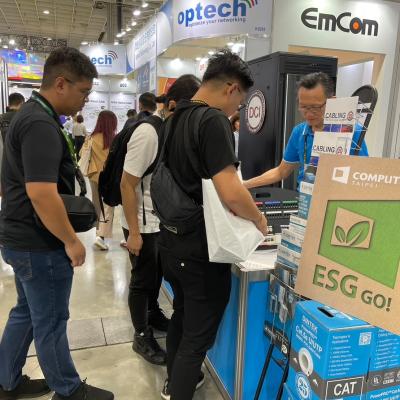Cat.6 vs Cat.6A
WHICH CABLE
SHOULD YOU CHOOSE?

Introduced in 2008, Cat.6A was the cabling designed to allow 10 Gigabit Ethernet transmission over a 100-meter distance. It offers improved specifications compared with the Cat.6 cable which was designed for 1 Gigabit Ethernet transmission over the same distance. The Cat.6A cable doubles data transmission bandwidth; decreases the chance of crosstalk interference, and provides superior reliability and transmission speeds through greater lengths of cable.
Comparing the two cables based on performance and speed, it would be easy to say that Cat.6A is the better choice, however when planning an installation there are many factors to be considered, and both Cat.6 and Cat.6A cables provide benefits depending on your specific requirements. Some of these factors are outlined below.
Equipment requirements
Cable requirements are often dictated by the equipment that is currently installed or will be installed in the near future. 99% of all network equipment will support Ethernet data cable speeds of 10 Mbp/s to 1 Gbp/s (1000 Mbp/s). So take stock of your current equipment. Does any of your equipment require or even support 10 Gbp/s (10,000 Mbp/s)? Do you have plans to upgrade your equipment to support this higher speed? If the answer is "yes", then Cat.6A cabling would be the cable of choice. Most of the time, however, the answer is "no". In which case, Cat.6A speed cable will not benefit you in any way, but it will certainly cost more.
Maximum lengths
For Cat.6 cables, maximum lengths depend heavily on network speeds and crosstalk conditions. For example, in lower speed networks such as 10, 100, or 1,000 megabit systems (the 10/100/1000BASE-T standards), the maximum cable length is 100 meters, with about 90% of that length used to transmit data between systems and the remaining 10% for the connection itself. When crosstalk conditions are ideal in higher speed 10 gigabit (10GBASE-T) networks, the maximum Cat.6 cable length is 55 meters, but it is only 33 meters when the potential for crosstalk is high, as when several cables are bundled tightly in one area.
Cat.6A cables make use of their higher standards by allowing full 10GBASE-T transmission speeds of up to 10 Gbps, at 500MHz of signal bandwidth, over 100 meters.
Wiring and insulation
Both Cat.6 and Cat.6A cables are made with eight copper conductors twisted into four pairs, with the Cat.6A cable often using thicker copper conductors and jackets.
Another similar, though relatively minor difference between both cables comes down to insulation. While it is possible to get shielded Cat.6 cables, unshielded versions are much more common. In contrast, nearly all Cat.6A cables are shielded. Extra shielding helps boost reliability and block out interference in areas that may suffer from heavy electromagnetic interference (EMI).
The average home office or small business user will rarely need a shielded Ethernet cable. Shielding benefits industrial environments the most.
Durability
Due to its new central column support and ubiquitous shielding, the Cat.6A is much heavier and bulkier than the Cat.6. Cable trays will not hold nearly as many Cat.6A cables as they can Cat.6 cables.
Though Ethernet cables can seem sturdy on the outside, their inner workings are fragile. In other words, it is important not to bend cables too much, as this can damage wiring and decrease performance quality. The minimum radius a cable can be bent without damaging it is called the bend radius. The lower the bend radius, the more you can bend the cable i.e., the more flexible it is. The bend radius is roughly four times the cable diameter. Because of their bulkiness, Cat.6A cables take up more room and have a larger bend radius than Cat.6 cables.
Power over Ethernet (PoE)
Power over Ethernet (PoE) is now a common platform. Both Cat.6 and Cat.6A cables are 23AWG. The Cat.6 cable has a small pair separator, making the overall diameter of the cable 6.5mm. The Cat.6A cable has a larger pair separator, which makes the overall diameter of the cable 8.5mm. This pair separator helps with the transmission speeds by balancing the cable pair structure further, reducing the possibility of noise interference from other power sources.
The separator also helps dissipate the small amount of heat that PoE produces. The pair separator gives the cable pairs more protection which makes the cable more robust.
Cost and ease of installation
The cost differences between Cat.6 and Cat.6A are relatively small, typically around 20-35%. For a small network, this could mean a difference of less than $100 in cable costs, however, when installing Cat.6A cable to achieve 10 Gigabit speed, the increase in costs is not only from the cabling. Extra costs are also incurred due to the need for higher performance switches and additional networking hardware. A single piece of network infrastructure, like cable, cannot be upgraded to Cat.6A specification and give you faster speeds. That is until the entire network infrastructure is upgraded.
The cost of installation also increases with Cat.6A cable from a labor standpoint. Cat.6A cable is heavier than Cat.6 and less flexible. It requires extra attention to detail to terminate properly. If there is no in-house expertise to properly install Cat.6A cabling, then a network cabling contractor is recommended.
The cost of installation also increases with Cat.6A cable from a labor standpoint. Cat.6A cable is heavier than Cat.6 and less flexible. It requires extra attention to detail to terminate properly. If there is no in-house expertise to properly install Cat.6A cabling, then a network cabling contractor is recommended.
Future upgrade considerations
There are two primary instances when the installation of Cat.6A cable is preferable to Cat.6:
1. You plan to make a move to 10 Gbp/s speed. Especially if you will have long runs, up to the maximum distance supported by Cat.6A - 328ft.
2. You're installing the cable where it would be cost-prohibitive to re-run higher specification cable even in the distant future.
1. You plan to make a move to 10 Gbp/s speed. Especially if you will have long runs, up to the maximum distance supported by Cat.6A - 328ft.
2. You're installing the cable where it would be cost-prohibitive to re-run higher specification cable even in the distant future.
In summary
There are two primary instances when the installation of Cat.6A cable is preferable to Cat.6:
1. You plan to make a move to 10 Gbp/s speed. Especially if you will have long runs, up to the maximum distance supported by Cat.6A - 328ft.
2. You're installing the cable where it would be cost-prohibitive to re-run higher specification cable even in the distant future.
1. You plan to make a move to 10 Gbp/s speed. Especially if you will have long runs, up to the maximum distance supported by Cat.6A - 328ft.
2. You're installing the cable where it would be cost-prohibitive to re-run higher specification cable even in the distant future.









